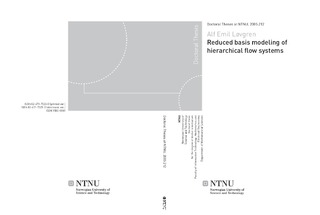| dc.contributor.author | Løvgren, Alf Emil | nb_NO |
| dc.date.accessioned | 2014-12-19T13:57:04Z | |
| dc.date.available | 2014-12-19T13:57:04Z | |
| dc.date.created | 2008-05-08 | nb_NO |
| dc.date.issued | 2005 | nb_NO |
| dc.identifier | 124326 | nb_NO |
| dc.identifier.isbn | 82-471-7321-2 | nb_NO |
| dc.identifier.uri | http://hdl.handle.net/11250/258143 | |
| dc.description.abstract | In this thesis we consider the reduced basis element method for approximating the solution of parameter dependent problems described by partial differential equations. In particular we focus on fluid flow in pipes, bifurcations and hierarchical systems, where the flow is described by the steady Stokes equations, or the steady Navier-Stokes equations. The thesis consists of four papers and this introduction.
The reduced basis element method is different from traditional reduced basis methods in that it combines these methods with domain decomposition. A given geometry is decomposed into building blocks with the same topology as a few reference domains, e.g. a rectangle and a reference bifurcation. Relative to each reference domain we precompute and store basis functions found on a preselected set of deformations of the respective reference domains. A reduced basis solution is then found by mapping the basis functions from their respective reference domains to corresponding domains in the domain decomposition. A local approximation of the “true” solution on one domain is found using the basis functions belonging to that specific domain, and the global approximation is found by “gluing” the local approximations together with constraints across domain interfaces. Geometries where building blocks of the same topology are reused many times are attractive candidates for the reduced basis element method. When there is only one domain in the geometry, the reduced basis element method is seen as a traditional reduced basis method where the geometry of the domain is one of the independent parameters.
In the first part of the introduction we present the reduced basis method and the reduced basis element method. In the second part of the introduction we motivate the work done in the thesis, and give a summary of the papers. | nb_NO |
| dc.language | eng | nb_NO |
| dc.publisher | Fakultet for informasjonsteknologi, matematikk og elektroteknikk | nb_NO |
| dc.relation.ispartofseries | Doktoravhandlinger ved NTNU, 1503-8181; 2005:212 | nb_NO |
| dc.relation.haspart | Løvgren, Alf Emil; Maday, Yvon; Rønquist, Einar. A reduced basis element method for the steady Stokes problem. Mathematical Modelling and Numerical Analysis. 40(3): 529-552, 2006. | nb_NO |
| dc.relation.haspart | Løvgren, Alf Emil; Maday, Yvon; Rønquist, Einar. A reduced basis element method for the steady Stokes problem: Application to hierarchical flow systems. Proceedings of SIMS 2005, 2005. | nb_NO |
| dc.title | Reduced basis modeling of hierarchical flow systems | nb_NO |
| dc.type | Doctoral thesis | nb_NO |
| dc.contributor.department | Norges teknisk-naturvitenskapelige universitet, Fakultet for informasjonsteknologi, matematikk og elektroteknikk, Institutt for matematiske fag | nb_NO |
